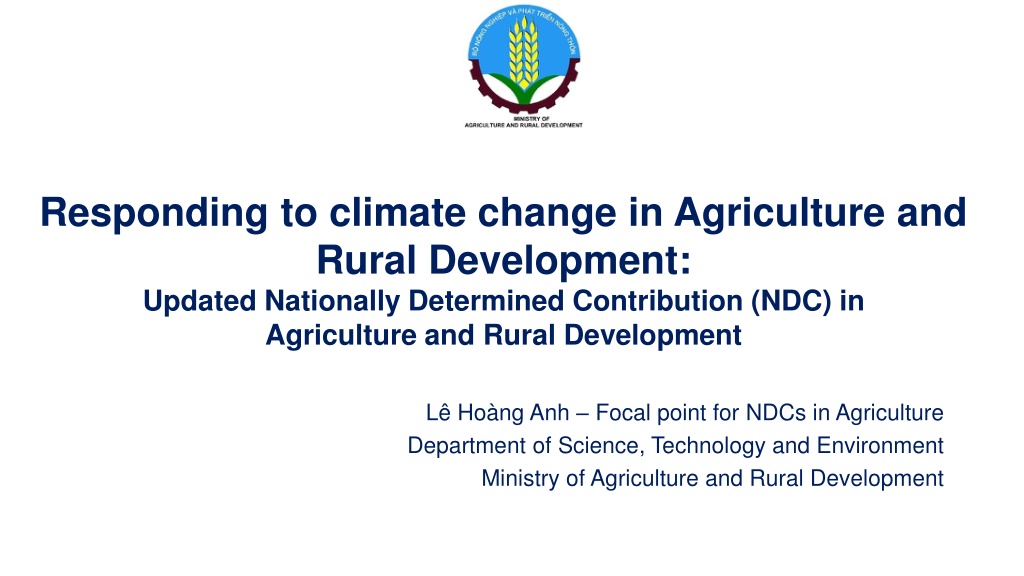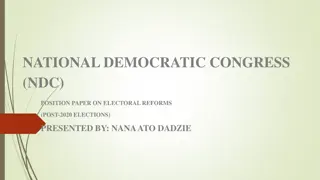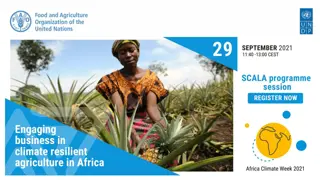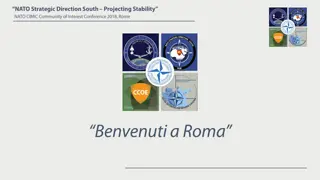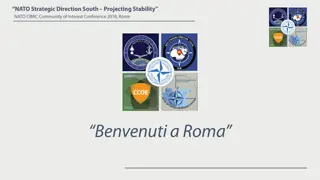Climate Change Response in Agriculture: Vietnam's Updated NDC
Vietnam is making strides in responding to climate change in agriculture and rural development through its updated Nationally Determined Contribution (NDC). The country is committed to implementing measures for GHG emission reduction and climate change adaptation, aligning with the Paris Agreement. Key focus areas include GHG mitigation, resource preparation, and establishing transparent monitoring systems. The government aims to create a conducive environment for climate change response while harmonizing socio-economic development.
Download Presentation

Please find below an Image/Link to download the presentation.
The content on the website is provided AS IS for your information and personal use only. It may not be sold, licensed, or shared on other websites without obtaining consent from the author. Download presentation by click this link. If you encounter any issues during the download, it is possible that the publisher has removed the file from their server.
E N D
Presentation Transcript
Responding to climate change in Agriculture and Rural Development: Updated Nationally Determined Contribution (NDC) in Agriculture and Rural Development L Ho ng Anh Focal point for NDCs in Agriculture Department of Science, Technology and Environment Ministry of Agriculture and Rural Development
National climate change policy context (2021-2030) National Adaptation Plan NAP_Ag 1055/Q -TTg 156/Q -BNN-KHCN 2053/Q -TTg 891/Q -BNN-KHCN National Plan for Paris Agreement Implementation National Plan for Paris Agreement Implementation_ Ag Climate change adaptation GHG emission reduction Co-benefits; Natural disaster risk management, L&D FinanceTransparency (MRV, M&E ...) Updated NDC 2020 NDC_Ag National Action Plan to Respond to CC National Action Plan to Respond to CC_Ag Document No. 9766/VPCP-NN consulting line ministries and local agencies National Socio-Economic Development Plan & Strategy 2021-2030 Completed and being completed at the national, sector, eco-regional, and local (provincial) levels.
PARIS AGREEMENT ON CLIMATE CHANGE Nationally Determined Contribution (NDC) Orientation for GHG emission reduction in agricultural production
THE PARIS AGREEMENT AND VIETNAMS COMMITMENT 1. Implement GHG mitigation commitments in Viet Nam s NDC; 2. Implement climate change adaptation commitments in Vietnam s NDC; 3. Prepare human, technological and financial resources to fulfill the commitments in Vietnam s NDC and contribute to transforming the economy towards low carbon emission and high resilience; 4. Establish and operate an public and transparent MRV system to monitor and assess the implementation of climate change adaptation, GHG emission mitigation, and resource preparation; 5. Complete institutional conditions and policies to create a favorable environment and prioritize national efforts for responding to climate change, including a situational assessment to adjust national policies, strategies and plans to harmonize climate change response and socio-economic development; strengthen coordination in handling inter-regional and inter-sectoral issues; attract private resources and international support.
THE PARIS AGREEMENT AND VIETNAMS COMMITMENT On 24th July 2020, the Prime Minister approved the updated NDC of Vietnam to submit to the UNFCCC (Document No. 1982/VPCP-QHQT issued by the Government Office. From 2021, Vietnam will implement measures to mitigate GHG emissions according to the NDC while taking actions to adapt to climate change within the medium and long-term investment programs suitable to the conditions and circumstances of Vietnam.
Vietnams NDC (2021-2030) By 2030: Vietnam will have reduced its GHG emissions by 9% compared to the BAU scenario by 2030 with its own domestic resources; up to 27% with international support Proactively respond to natural disasters and strengthen climate monitoring Industrial processes Energy Agriculture Ensure social security Mitigation component Adaptation component LULUCF Respond to sea level rise and urban inundation Waste
Key updates in the NDC Reviewed and updated Vietnam s mitigation and adaptation contributions to be more in line with the country s current situation and latest socio- economic development forecasts for up to 2030: Ensured that NDC implementation objectives are in line with the objectives of the Socio-Economic Development Strategy, the National Climate Change Strategy, the Viet Nam Green Growth Strategy, and the National Strategy for Natural Disaster Prevention, Response and Mitigation Clarified issue of loss and damage and included Viet Nam's latest efforts in responding to climate change Added the analysis of co-benefits of adaptation, mitigation, and sustainable development. Included a national system for measurement, reporting and verification (MRV) for mitigation actions and a monitoring and evaluation (M&E) system for adaptation actions in order to implement the NDC.
Key updates in the NDC Adaptation component:Identify strategic tasks to improve adaptation efficiency through increased governance There are 12 adaptation measures in Agriculture and Rural Development : - Forecast and early warning of hydro-meteorological information for agricultural production; - Crop and livestock restructuring, crop arrangement; - Improvement of farming techniques (soil preparation, fertilization, water management, seeds, etc.); - Research and development of new varieties with high adaptability to changing climate conditions; - Development of synthetic models, CSA models, agroforestry, intersectoral models; - Strengthening sustainable forest protection and environmental management GHG mitigation component: - By 2030: reduction of 9% with domestic resources and 27% with international support - Baseline year: 2014, total GHG emissions were 284 MtCO2eq, in which Ag-emissions were 89.8 MtCO2eq (31.6%); - 75 technical measures to mitigate GHG emissions (in which: 15 in the agriculture (crop production and animal husbandry), 12 measures in the LULUCF sector)
New points in the updated NDC: Proposed to the Secretariat of the of the United Nations Framework Convention on Climate Change in September 2020 9% by 2030 compared to the BAU scenario (with domestic resources) 27% by 2030 compared to the BAU scenario (with international support) Change of Baseline year What s new? Added industrial processes IP sector 75 GHG mitigation measures, 15 in the agriculture sector, 12 in the LULUCF sector Increased commitment indicators to facilitate regular M&E of NDC implementation progress M&E system Included loss and damage Adaptation NDC C pnh t MRV methodology and system in NDCimplementation MRV system ngl i ch Co-benefit assessment among adaptation mitigation sustainable development Socio- economic development Included impact assessment of the implementation of mitigation measures on socioeconomic development
GHG EMISSIONS IN DIFFERENT SECTORS Unit: MtCO2eq Sector 1994 2000 2010 2013 2014 Energy 25.6 52.8 141.1 151.4 171.6 IPPU 3.8 10.0 21.1 31.8 38.6 Agriculture 52.4 65.1 88.4 89.4 89.7 LULUCF 19.4 15.1 -19.2 -34.2 -37.5 Waste 2.6 7.9 15.4 20.7 21.5 Total 103.8 150.9 246.8 259 283.9 Source: 3rd National Announcement to the UNFCCC
National (BAU) GHG emissions baseline Million tonnes CO2 equivalent Total Agriculture Energy Waste IPPU
Estimates of GHG emissions in Agriculture in 2020 and 2030 Unit: thousand tonnes CO2 equivalent 2010* 2020** 2030*** Source Emissions % Emissions % Emissions % Animal husbandry 18,030 20.4 24,948 24.8 29,322 26.8 Rice farming 44,614 50.5 39,360 39.1 39,949 36.5 Agricultural land 23,812 27.0 33,947 33.6 37,397 34.3 Savanna burning x6 x x In-field agricultural residue burning 1,899 2.1 2,504 2.5 2,673 2.4 Total 88,355 100 100,758 100 109,342 100 Project Strengthening capacity for national GHG inventory in Vietnam , 2014 ** Report on estimates of GHG emissions in Vietnam s agriculture in 2020, 2030, 2014
Nationally Determined Contribution (NDC) Vietnam s contributions in GHG mitigation by 2030 compared to BAU: Contribution with domestic resources Contribution with international support Total contribution in Vietnam s NDC Compared with national BAU (%) Compared with national BAU (%) Sector Compared with national BAU (%) Reduction (MtCO2eq) Reduction (MtCO2eq) Reduction (MtCO2eq) Energy 5.5 51.5 11.2 104.3 16.7 155.8 Agriculture LULUCF* Waste IP Total 0.7 1.0 1.0 0.8 9% 6.8 9.3 9.1 7.2 83.9 2.8 1.3 2.6 0.1 18% 25.8 11.9 24.0 0.8 166.8 3.5 2.3 3.6 0.9 27% 32.6 21.2 33.1 8.0 250.8 13
Framework for selecting GHG mitigation measures in agriculture and rural development sector MRV: Ability to measure and calculate emissions (M), Ability to aggregate and report (R), Ability to verify data (V) (i) Response to climate change, (ii) Economy, (iii) Society, (iv) Environment, (v) Institutions and Policy (20 indicators) Co-benefits MACC Indicators: Scalability (Maximum Potential Scale), Mitigation potential, MAC, Initial investment costs, Payback period - CBA Indicators: Scale, Initial Investment Cost, NPV/year/unit (EAA) and Internal Rate of Return (IRR) M&E: Specific (S), Measurable (M), Achievable (A), Relevant (R), and Time-bound (T) MRV/M&E Criteria for selection of measures CBA/MACC Technical feasibility - Household (small scale) - Farm/cooperative (medium scale) - Company (large scale) Scale Maximum scalability
GHG emission reduction measures and co-benefits of the Agriculture sector Water management and wet rice cultivation practices (CSA: AWD, SRI, ICM, 1M5R, 3R3G, efficient use of fertilizers, changing the cropping calendar ...) Water management and upland crop (crop structure change, intercropping, water management, ...) Management, recycling/reuse of crop residues (control of straw burning, composting etc.) Livestock waste management (biogas, composting, organic fertilizer production, etc.); Improve fertilizer use efficiency; Improve feed rations and control rumen fermentation of ruminants LULUCF Forest protection and restoration; C stock enhancement and soil conservation; Agroforestry, Sustainable forest management.
Assumptions in developing mitigation measures in Agriculture Measure Timeline Assumption A1. Alternate wetting and drying (AWD) and improved rice farming systems (SRI) in areas with sufficient infrastructure. 2021-2030 By 2030, the Government will have implemented AWD and SRI on 200,000 ha compared to the current adoption on 45,000 ha A2. Mid-season drainage (MSD) 2021-2030 By 2030, MSD will have been implemented on 1 million ha to reduce GHG emissions while saving water and improving crop s resilience A3. Converting specialized rice land to rice-aquaculture land 2021-2030 By 2030, 200,000ha specialized rice land with low and unstable productivity will have been converted to shrimp land to reduce GHG emissions while increasing economic benefits and farmers income A4. Converting specialized rice to upland crops 2021-2030 By 2030, 200,000ha specialized rice land with low and unstable productivity will have been converted to upland crops to adapt to draught/water shortage conditions and reduce GHG emissions A5. Improve the quality of dairy cow diets 2021-2030 By 2030, the Government will have implemented support for farmers to improve rations for 400,000 dairy cows compared to current rations to increase productivity and production of the current dairy cow herds A6. Improve diet quality for beef cattle 2021-2030 By 2030, the Government will have implemented support for farmers to improve rations for 2 million beef castles compared to current rations to increase productivity and meet production of the current beef cattle herds A7. Improve diet quality for buffalo 2021-2030 By 2030, the Government will have implemented support for farmers to improve rations for 500,000 buffalos compared to current rations to increase productivity and meet production of the current buffalo herds A8. Reuse of agricultural by-products 2021-2030 By 2030, residue of 1.2 million ha will have been collected to make compose and supplement organic fertilizer for crop production
Githit trong xy dng cc bin php gimnhcalnhvc nng nghip Measure Timeline Assumption A9. Integrated Crop Management (ICM) for rice 2021- 2030 By 2030, ICM will have been adopted on 1 million ha of rice area to reduce inputs, implement integrated cultivation, increase economic benefits, improve agricultural environment quality A10. Integrated crop management for upland crops (ICM) 2021- 2030 By 2030, ICM will have been adopted on 1 million ha of upland crops to reduce inputs, implement integrated cultivation, increase economic benefits, improve agricultural environment quality A11. Replace urea fertilizer with slow- soluble nitrogen 2021- 2030 By 2030, urea fertiliser will have been replaced with (NH4)2SO4 on 3.5 million cropland to reduce GHG emissions A12. AWD and SRI in wet rice cultivation in areas with medium infrastructure. 2021- 2030 With international support, by 2030, AWD and SRI will have been adopted on 5,000 ha of rice area A13. AWD and SRI in wet rice cultivation in areas with poor infrastructure 2021- 2030 With international support, by 2030, AWD and SRI will have been adopted on 1 million ha of rice area A14. Drip irrigation combined with fertilizer for coffee 2021- 2030 With international support, by 2030, dripped irrigation combined with fertilizer will have been applied on 450,000 ha of coffee A15. Improving technology to reuse livestock waste as organic fertilizer 2021- 2030 With international support, technology will have been improved to produce organic fertilizer from the waste of 44 million cattle heads for sustainable agricultural production.
Potential, costs and financial needs of GHG mitigation measures in agriculture with domestic resources Mitigation potential (MtCO2eq) Abatement cost (USD/ tCO2eq) Financial needs (2021-2030) (million USD) Measure 2021-2030 2030 A1. Alternate wetting and drying (AWD) and improved rice farming systems (SRI) in areas with sufficient infrastructure. 5.2 0.9 39.6 181.1 A2. Mid-season drainage (MSD) 17.6 3.2 30.0 1,027.3 A3. Converting specialized rice land to rice-aquaculture land 7.2 1.3 -293.2 181.8 A4. Converting specialized rice to upland crops 7.9 1.4 -0.1 0.036 Total 37.9 6.8 1,390.2 Baseline year: 2014, Discount rate: 10%
Potential, costs and financial needs of GHG mitigation measures in agriculture with domestic resources Mitigation potential (MtCO2eq) 2021-2030 Abatement cost (USD/ tCO2eq) Financial needs (2021-2030) (million USD) Measure 2030 A5. Improve the quality of dairy cow diets 0.5 0.1 89.0 5.5 A6. Improve diet quality for beef cattle 6.4 0.3 89.0 27.3 A7. Improve diet quality for buffalo 1.7 0.1 89.0 6.8 A8. Reuse of agricultural by-products 0.7 0.1 63.2 30.0 A9. Integrated Crop Management (ICM) for rice 2.75 0.5 20.0 9.1 A10. Integrated crop management for upland crops (ICM) 1.8 0.3 25.0 9.1 A11. Replace urea fertilizer with slow-soluble nitrogen 30.8 5.6 30.0 15.9 A12. AWD and SRI in wet rice cultivation in areas with medium infrastructure. 25.7 4.7 65.0 795.5 A13. AWD and SRI in wet rice areas with poor infrastructure 25.7 4.9 94.9 2,075.0 A14. Drip irrigation combined with fertilizer for coffee 9.4 1.7 124.2 1,227.3 A15. Improving technology to reuse livestock waste as organic fertilizer 37.4 7.5 94.9 2.0 Total 146.6 25.8 4.203.5 Baseline year: 2014, Discount rate: 10%
Remarks Policy and institutions: Action plan/Iingmplementation plan; development of guidelines for integrating and controlling land use conversion; low carbon development; carbon trade, etc. Transfer of technical progress; building MRV system; practice smart, linked / collaborative farming models; improving the efficiency of resource use (land, water, fertilizers, pesticides, etc.; Capacity enhancement; propaganda and awareness raising; international cooperation in information sharing and resource mobilization
